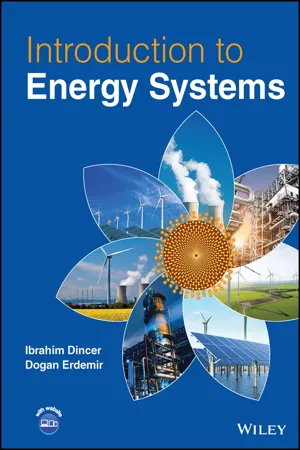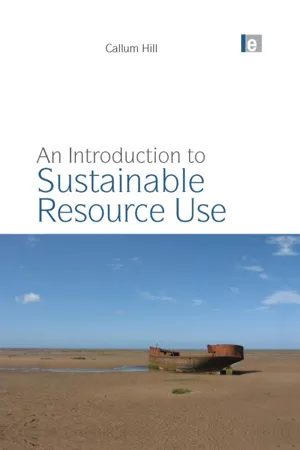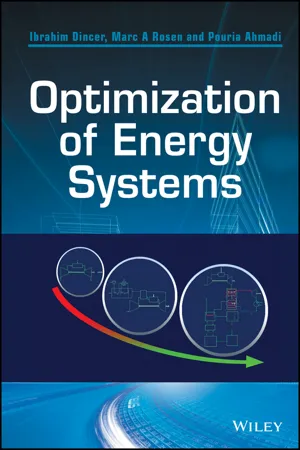Technology & Engineering
Open System Thermodynamic
An open system in thermodynamics refers to a system that can exchange both energy and matter with its surroundings. This means that the system is not isolated and can interact with its environment. Open systems are commonly found in various engineering and technological applications, allowing for the transfer of energy and materials, making them important for understanding real-world processes.
Written by Perlego with AI-assistance
Related key terms
Related key terms
1 of 4
Related key terms
1 of 3
6 Key excerpts on "Open System Thermodynamic"
- eBook - ePub
- Michael J. Moran, Howard N. Shapiro, Daisie D. Boettner, Margaret B. Bailey(Authors)
- 2018(Publication Date)
- Wiley(Publisher)
national power transmission grid is in place. If this vision of mid-century life is correct, it will be necessary to evolve quickly from our present energy posture. As was the case in the twentieth century, thermodynamics will contribute significantly to meeting the challenges of the twenty-first century, including using fossil fuels more effectively, advancing renewable energy technologies, and developing more energy-efficient transportation systems, buildings, and industrial practices. Thermodynamics also will play a role in mitigating global climate change, air pollution, and water pollution. Applications will be observed in bioengineering, biomedical systems, and the deployment of nanotechnology. This book provides the tools needed by specialists working in all such fields. For nonspecialists, the book provides background for making decisions about technology related to thermodynamics—on the job, as informed citizens, and as government leaders and policy makers. 1.2 Defining Systems The key initial step in any engineering analysis is to describe precisely what is being studied. In mechanics, if the motion of a body is to be determined, normally the first step is to define a free body and identify all the forces exerted on it by other bodies. Newton's second law of motion is then applied. In thermodynamics the term system is used to identify the subject of the analysis. Once the system is defined and the relevant interactions with other systems are identified, one or more physical laws or relations are applied. The system is whatever we want to study. It may be as simple as a free body or as complex as an entire chemical refinery. We may want to study a quantity of matter contained within a closed, rigid-walled tank, or we may want to consider something such as a pipeline through which natural gas flows. The composition of the matter inside the system may be fixed or may be changing through chemical or nuclear reactions - eBook - ePub
- Ibrahim Dinçer, Dogan Erdemir(Authors)
- 2023(Publication Date)
- Wiley(Publisher)
To further note that in order to design and operate energy systems, all criteria given above should be considered carefully to maximize the useful outputs and minimize the energy or fuel inputs. Today, as thermodynamics part of the any system which has energy flows, thermodynamic approaches are deployed in almost all sectors from energy to environment, from economy to social sciences. The ultimate aim of the thermodynamic analysis is to better understand the energy systems and processes. A better understanding helps to improve the systems further. Thermodynamically improved systems can provide more effective results in many ways like less fuel consumption, power generation, the number of useful outputs, economy, environmental impacts, etc.Thermodynamics, as mentioned in the beginning, is directly linked to many things, including energy, environment, economy, and hence sustainability as a big picture. Thermodynamics is then located at the intersection of these four key domains, as illustrated in Figure 3.2 . Better thermodynamic performance can provide better performance indexes for energy, environment, economy, and sustainability. Therefore, in order to design optimum energy systems, thermodynamic analysis is the first step. It is an essential tool to assess and optimize systems and system components.Thermodynamics as an intersection of energy, environment, economy, and sustainability.Figure 3.2In order to better understand thermodynamics, Dincer [1 ] has introduced a seven-step approach. These steps are important to really comprehend with the spectrum of thermodynamics in a logical manner as illustrated in Figure 3.3 - eBook - ePub
- Callum Hill(Author)
- 2012(Publication Date)
- Routledge(Publisher)
Historically, thermodynamics concerned itself with properties such as work, energy and heat at a time before it was known that matter was made of atoms. As we have seen, the caloric theory was in favour until about 1850 when it was finally realized that heat was just one form of the many different types of energy. It was also about this time that thermodynamics began to gain a firm scientific footing.Rather than limiting itself to machines, thermodynamics developed a more generic approach; one very important concept which was introduced was that of the system. A system comprises something we wish to study, which might be a heat engine, but could be anything (Atkins, 1986; Everett, 1971). Around the system are the surroundings and between the two is something called a system boundary. The boundary may have a physical existence, or it can be purely conceptual. The experi- mental system boundary is the place where measurements are taken, with energy and sometimes matter flowing across this boundary. Different systems can be defined and described as either open, closed or isolated. An open system is one that can exchange matter and energy through the boundary with its surroundings, a closed system can exchange energy but not matter and an isolated system cannot exchange matter or energy with its surroundings.The surroundings represent everything that is not in the system, in other words the rest of the universe. When something passes through the system boundary, this changes the internal energy of the system. This might be heat energy passing through, or we might perform mechanical work on the system (such as compressing air in a bicycle pump). This idea is stated in the First Law of Thermodynamics. - eBook - ePub
- Mike Pauken(Author)
- 2011(Publication Date)
- For Dummies(Publisher)
If you’ve ever pulled into a gas station and filled up a tire that was looking a little deflated, you’ve used an open system. See, you’ve used thermodynamics without even realizing it!This chapter introduces you to thermodynamic analysis of some simple processes involving heat and work for open systems. The concepts using the first law of thermodynamics I discuss here are similar to the ones presented in Chapter 5 for closed systems. The difference between an open system and a closed system is whether or not a fluid is allowed to flow into or out of a system. You may be able to guess by their names that a fluid can’t flow in a closed system, but it can flow in an open system.Some examples of simple open systems include heat exchangers, pumps, compressors, turbines, and nozzles. These devices are used in more complicated systems such as power plants, air-conditioning systems, and jet engines, which I discuss in Chapters 10–13.Conserving Mass in an Open System
The best way to begin every thermodynamic analysis is by defining a system. A system describes a region enclosed by an imaginary boundary (which may be fixed or flexible) that contains a mass or volume to use for analysis. A system that doesn’t allow mass to enter or leave is called a closed system . The mass inside a closed system is often called the control mass. A system that allows mass to enter and leave is called an open system. The volume of an open system is often called the control volume.This chapter focuses on thermodynamic analysis using the conservation of mass and conservation of energy for open systems. Conservation of mass means that the mass flow rate of material entering a system minus the mass flow rate leaving equals the mass that may accumulate within the system, as described by this equation:When you see a “dot” over a variable like mass ( - eBook - ePub
- Ibrahim Dinçer, Marc A. Rosen, Pouria Ahmadi(Authors)
- 2017(Publication Date)
- Wiley(Publisher)
the elevation. In order to apply the FLT to an energy system, we need to know some further concepts, which are described in the following sections.1.3.1 Thermodynamic System
A thermodynamic system is a region or device or combination of devices that contains a certain quantity of matter. It is important to carefully define the system under consideration during an analysis and its boundaries. Three important types of systems can be defined:- Closed system. Such a system is defined as one across the boundaries of which no material crosses. It therefore contains a fixed quantity of matter. Sometimes this is also called a control mass.
- Open system. This is defined as a system in which material (mass) is allowed to cross the boundaries. The term open system is sometimes referred to as a control volume.
- Isolated system. This is a closed system that is independent and unaffected by the surroundings. No mass, heat, or work crosses its boundary.
1.3.2 Process
A process is a physical or chemical change in the properties of matter or the conversion of energy from one form to another. In some processes, one property remains constant. The prefix “iso” is employed to describe such as process, for example isothermal (constant temperature), isobaric (constant pressure), and isochoric (constant volume).1.3.3 Cycle
A cycle is a series of thermodynamic processes in which the end point conditions or properties of the matter are identical to the initial conditions.1.3.4 Heat
Heat is the thermal form of energy, and heat transfer takes place when a temperature difference exists within a medium or between different media. The definitive experiment that showed heat to be a form of energy, convertible into other forms, was carried out by Scottish physicist James Joule. Heat transfer always requires a difference in temperature, and higher temperature differences provide higher heat transfer rates. The units for heat are joules or kilojoules in the International System (SI) and the foot pound force or British thermal unit (Btu) in the English system. In terms of sign conventions in thermodynamic calculations, a common one states that heat transfer to a system is considered positive, while heat transfer from a system is negative. If there is no heat transfer involved in a process, it is called adiabatic. - Stanislaw Sieniutycz, Jacek Jezowski(Authors)
- 2013(Publication Date)
- Elsevier(Publisher)
The scope of this chapter is not only to review and classify the main methods and results obtained in the field but also to consider common objections caused by misunderstanding of these methods and results. In fact, the second part of the chapter contains a critical comparison of various methods applied for the systems of energy generation, such as second-law analyses, entropy generation minimization, approaches coming from ecology, and finite-time thermodynamics. Systems considered are those with transfer or rate processes that occur in a finite time and in equipment of finite dimensions. These processes include heat and separation operations and are found in heat and mass exchangers, thermal networks, energy convertors, energy recovery units, storage systems, chemical reactors, and chemical plants.11.2 System energy analyses
In process analysis the assessment of energy impact is constrained to the interior of the balance shield of the considered unit; this is how direct energy consumption is determined. Yet it should be realized that no real energy unit can operate as a separate system but is a component of a global energy system. In fact, the production and consumption of energy carriers always takes place within the network of interconnected thermal units. Therefore, both the direct consumption of energy carriers in the unit investigated and the indirect consumption occurring in other units must be analyzed. For this purpose the system approach should be applied (Bertallanffy, 1973 ; Klir, 1972 ; Leontief, 1951 ; Mielentilew, 1982 ). Application of the system approach to investigate problems of industrial thermal engineering started in the 1960s. The elaboration of a mathematical model for material and energy balance of an industrial plant using the example of ironworks may be considered (Szargut and Ziębik, 1972 ).11.3 Mathematical modeling of industrial energy management
To proceed in a systematic way, a total system is often divided into subsystems. In an industrial plant the technological subsystem (consisting of technological processes) and the energy subsystem (energy management) are distinguished. The production of the energy branches is intended to cover the needs of the technological branches and, partially, also the plant’s own consumption. The complexity of connections between energy management and technological branches, as well as the interdependences between the energy branches, causes the total energy management of an industrial plant to be more than the sum of energy processes considered separately. Some of these relations are of a feedback character. Therefore, all balance equations of energy carriers should be investigated as a whole. Thus, the energy management of an industrial plant is a system defined as a set of energy equipment and engines, as well as the inner relations between them and the external relation between energy management and the environment, the aim of which is the production, conversion, transmission and distribution of energy carriers consumed in industrial plants. Because of these relations energy management, treated as a complex, has attributes which its parts (the particular energy branches considered separately) do not possess.
Index pages curate the most relevant extracts from our library of academic textbooks. They’ve been created using an in-house natural language model (NLM), each adding context and meaning to key research topics.
Explore more topic indexes
Explore more topic indexes
1 of 6
Explore more topic indexes
1 of 4





